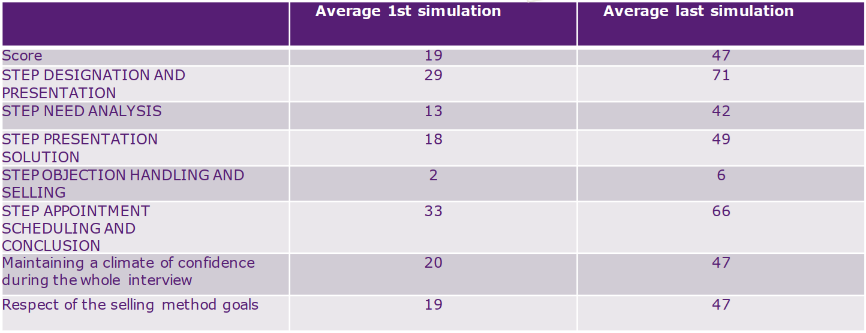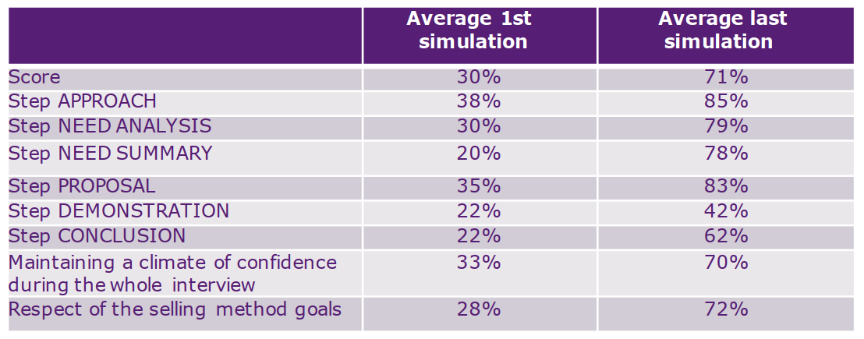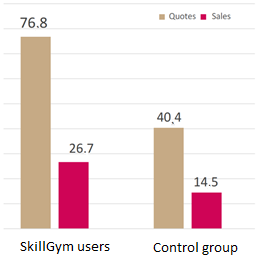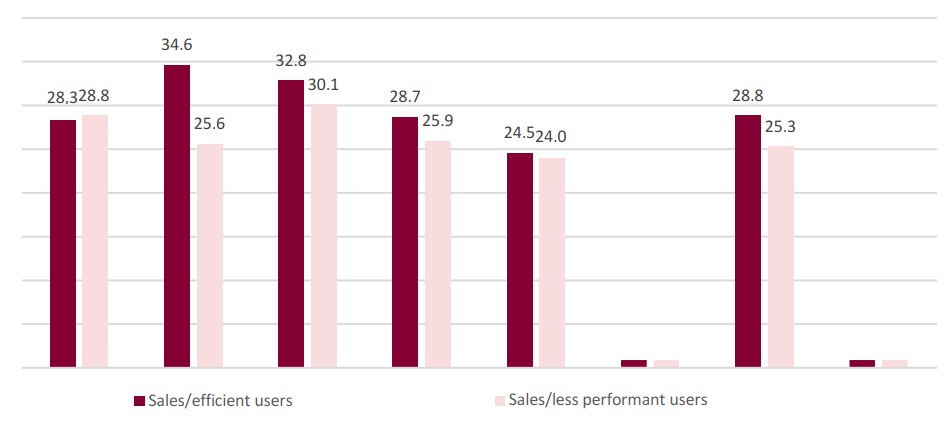
Is leadership a prerogative of managers only?
We believe that leadership skills are not just a domain of management, since they can be expressed in various activities like listening, motivating and driving whatever the person we have conversation with.
They have the power to shape the context and achieve objectives. So, if well practiced, conversational skills can help any role to achieve leadership.
In this case study, we will see what happens when practice is for sales people. Our objective was to identify if there is a correlation between the use of a Digital Role Play and the increase of job performance in the trainees.
For this purpose, the number of sales actually made by each agent after the training is a suitable and tangible element to rely on, especially because it is compared with their performance before the training, and with the performance of a control group who did not train with a simulator.
Measuring impact of soft skills training is difficult
Measuring soft skills is often a difficult task, and even more difficult is to measure the effect of a soft skills training with real-life indicators, such as the impact on sales.
Identifying the ROI of a training course is a struggle for all trainers and coaches around the world due to the missing immediate correlation with real, tangible results.
That’s why we have implemented a methodology based on a simulation of a real-life situation, with a specific learning design and accurate analytics, where users have to use the same skills from their everyday practice, measured by the software.
Identifying the ROI of a training course is a struggle for all trainers and coaches around the world.
Why digital?
Role play is an important resource for the development of soft skills, since it allows the learners to practice the critical conversations of their role and discuss the outcomes of this experience. Universal issues associated with this methodology are the necessary time commitment and difficulty in scalability, which relegate it as a niche tool or as a resource targeted only toward high-level and expensive training throughout most of the world.
A Digital Role Play is easily scalable, thus letting a greater number of learners profit from it, also relieving them from the time and location constrictions.
How Digital Role Play works
The SkillGym simulator is an interactive movie operated by artificial intelligence in which the user engages in a conversation with a virtual but authentic character in a context specifically designed to challenge his skills.
The dialogue between the user and the customer takes place by selecting from a set of questions and answers, which are designed to fit the most common communications styles and possible mistakes related to good communication rules as well as the selling model created by the company.
Each sentence that the user can choose represents one or more observable behaviors and allows the flow of the conversation to follow one’s own style and topics. If the user would not use any of the three sentences presented, he is encouraged to select the one he feels is the closest to his style.
The interface is clear and self-explanatory, so the user does not have to learn how to use the tool and can concentrate on the experience and the contents. It is also possible to activate subtitles and voice-over if needed.
Before and after every user interaction, the customer is “alive” and waiting so that the user can analyze his body language to understand if he is comfortable, under stress, etc.
Even if we aim to reproduce a real-life situation where time matters, the user has the possibility to pause the simulation if he needs to manage an important task that emerges during the training.
Simulation Based Learning (SBL) [1] is a rapidly growing paradigm in education. From the days of simple hyperlinked versions of textbooks, digital learning systems have evolved to complete simulation environments in which students are placed in complex, life-like situations.
It has been shown that these systems provide definite advantages in terms of learning efficiency [2][3].
Role play is an important resource, but the issues of time commitment and difficulty in scalability relegate it as a niche tool for high-level training. Until today.
Our experience
The Digital Role Play we proposed consisted of two different scenarios about a sales meeting: one about distance selling (by phone) and one about face-to-face selling. The products considered were a car insurance policy and a comprehensive household insurance policy.
We have trained a group with the simulator and a control group with a different, classical training methodology.
After six months, we compared the results before and after the training of the two groups, also comparing their real-life sales results in terms of quotes and sales.

An example of a SkillGym simulation
Our objective was to identify if there is a correlation between the use of a Digital Role Play vs traditional learning, and the increase of conversion rate in the trainees.
The numbers
The whole analysis involved 13,755 salespeople from a banking and insurance company, from eight different facilities all around the country.
During the training period, 23,909 simulations were made, with an average of 5 simulations completed per user.
The maximum possible score was 100; the average score was 52.6 and the average best score for the users was 68.
With regard to diligence and performance, 15% of the SkillGym users completed at least 10 simulations (2 times the average). Of that group, 21% reached a best score equal to or greater than 85.
Virtual sales results improved
As a first step, we compared the average score attained by the simulator users at the beginning and at the end of the training period.
For the simulator that mimics a phone sale, we observed an increase in the average score reached by users from 19 to 47 points.
The face-to-face simulator showed a similar trend, but with higher results. Users scored an average of 30 at the beginning of the training and an average of 71 at the end.
This score represents the confidence of the user, i.e., his ability to face the virtual interview like a routine task without too much stress and with a clear process in mind.
This data demonstrates that the trainees actually improved their virtual sales confidence by using Digital Role Play.
Figures 1 and 2 show a detail of the average score for each phase of the interviews at the beginning and at the end of the training activity.

(Fig.1) Average results for each phase of the interview – phone meeting simulator

(Fig.2) Average results for each phase of the interview – face-to-face meeting simulator
Real-life performance improved too!
As a second step, we compared the evolution of salespeople’s real-life sales results between the group who trained with the simulator and the control group who did not use it.
The group who trained on the simulator managed to conclude a customer meeting with a quote 76.8% of the time, while the control group concluded a customer meeting with a quote only 50.5% of the time, indicating a difference of 26.3 percentage points.
With regard to actual sales, the group who trained on the simulator managed to conclude a customer meeting with a sale 26.7% of the time, while control group did it only 18.3% of the time, resulting in a difference of 8.4 percentage points.
Moreover, we analyzed the performance of a smaller sample on the gross sales made by 1,150 salespeople. In the period studied, the increase of the gross sales made by the group who trained on the simulator was 42%.
This is a pretty good result considering that in the same period, the overall average increase of gross sales was only 17%.

Impact on quotes and sales
People who trained with SkillGym Digital Role Play achieved better real-life results as compared to the control group.
Diligent users sell more
We considered a user as “diligent” when he/she completed more than 10 simulations. To compare “diligent” and “non-diligent” users, we excluded the facilities that had less than 100 “non-diligent” users, because it wasn’t significant enough.
So, for this particular analysis, we have considered only three out of the eight company facilities.
In the three cases studied, diligent users always sold more than non-diligent users (32.4% vs. 30% in the first case, 29.9% vs. 25.9% in the second, and 29.4% vs. 25.3% in the third).
Efficient users sell more
We considered a user as “efficient” when he/she reached a best score of at least 85%. To compare “efficient” and “non-efficient” users, we excluded the facilities that had less than 100 “non- efficient” users, because it wasn’t significant enough.
In only one out of eight facilities did the efficient users sell 2% less than non-efficient users.
In all other cases, “efficient” users sold slightly more than “non-efficient” users, as shown in the figure below.

Efficient users sell more
The importance of authenticity
The simulators used in this training activity are designed with authenticity and realism in mind. They follow the company’s selling model while using cases experienced in real life by subject matter experts when creating the stories and the scripts.
The skills trained in the simulators (the ones needed to achieve good performance in the virtual interviews) are the same that salespeople will use in real life.
This is why we believe that the SkillGym methodology allows people to “train by doing” in a virtual environment that is absolutely authentic and realistic, so that the improvement they gain in the simulators can be transferred to real life.
It’s always great to witness how SkillGym impacts real life behaviors. This case study is simply amazing: performance had a huge impact on people, turning those who took the practice seriously into real Leaders of their role and profession.
You may want to read another article (“10 Reasons Why You Should Consider SkillGym for Your Next Leadership Development and Maintenance Program”) in which we outline, in more general terms, how the introduction of SkillGym can be beneficial for your organization.
And if you want to test SkillGym, please book a 1-hour discovery call here.
Bibliography
[1] S. Barry Issenberg, William C. McGaghie, Emil R. Petrusa, David Lee Gordon, and Ross J. Scalese. “Features and Uses of High-Fidelity Medical Simulations That Lead to Effective Learning: a BEME Systematic Review”. Medical Teacher, 27(1):10{28}, 2005.
[2] Margaret Bearman, Debra Nestel, and Pamela Andreatta. “Oxford Textbook of Medical Education”. Oxford University Press, 2013.
[3] De Ascaniis S., Cantoni L., and Sutinen E. and Talling R. “A Lifelike Experience to Train User Requirements Elicitation Skills. In Design, User Experience, and Usability: Understanding Users and Contexts.” DUXU 2017. Lecture Notes in Computer Science, vol. 10290. Springer, Cham, 2017.
